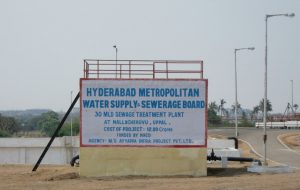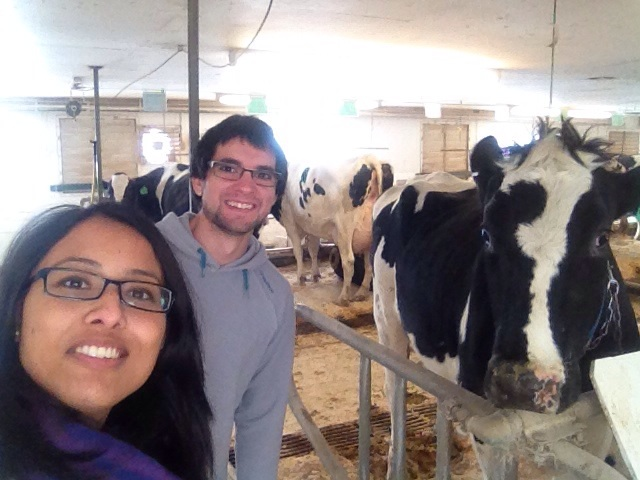Tag Archives: water-wastewater
News
Study of Wastewater Treatment and Reuse in Urban Ag Receives Press in India

The Indian Express newspaper (link below) reports on a study in Hyderabad, India that identifies the linkages between urban agricultural practices, sewage treatment and reuse, carbon emissions and health. Network member Anu Ramaswami (University of Minnesota), Leslie MiIler-Robbie (University of Colorado, Denver) and Priyanie Amerasinghe (International Water Management Institute) collaborated on this study, recently published in the journal Environmental Research Letters (Link to article). The study finds that sewage treatment along with water reuse in urban agriculture can offer benefits to carbon mitigation and public health, although the public health benefits are less than expected due to farming practices and prior history of sewage-related soil pollution in the region.
Climate change: Untreated sewage major contributor in The New Indian Express
The carbon emission benefits of sewage treatment are large since untreated sewage discharged to rivers converts to methane which is a potent greenhouse gas. Untreated sewage and household waste, along with emissions from burning of petrol and diesel in cars, and coal to provide electricity are among the major contributors to greenhouse gas emissions in cities.

News
Virtual Forum: Water-Wastewater and Stormwater-Green Infrastructure, Pt. 1
Join us today, Friday, 4/14, for a discussion on: Water-Wastewater and Stormwater-Green Infrastructure, Pt.1:
Led by: Dr. Paige Novak (University of Minnesota) & Dr. Lut Raskin (University of Michigan)
Discussing: What does (and can and should) wastewater treatment look like in the context of an integrated, distributed FEWS network?
Friday April 14, 2:30 to 4:30 PM Central
To view or join the discussion on Friday: Join Here, Access Code: 383-419-437.
These lectures and discussions are part of a course offered by the MSSTEP Program and the Sustainable Healthy Cities Network, Infrastructure Transformations for Sustainable Healthy Cities: Design and Policy.


News
Student Feature: Turning waste into biofuel by Shilva Shrestha and Xavier Fonoll at UMich
Shilva Shrestha, a current PhD student, and Xavier Fonoll, a post-doctoral fellow, in Professor Lutgarde Raskin’s research group at the University of Michigan, started a collaborative project between the University of Michigan, the University of Hawaii, and the University of Barcelona. They started working as a visiting master’s student and a visiting PhD student, respectively, at the University of Michigan in the summer of 2014. Impressed with the work atmosphere, rigor, and diverse approaches to research in the Raskin research group, both of them decided to take their collaboration further and returned to the University of Michigan after finishing their degrees at the University of Hawaii and the University of Barcelona, respectively, to start another phase of their research careers. Here is a brief introduction to their current work:
Annual worldwide waste generation is expected to increase by 70% by 2025. At the same time, there has also been a paradigm shift in our approach to waste treatment, transitioning from simple landfill disposal or incineration to utilizing waste to produce fuels and chemicals. Anaerobic digestion (AD) has been a popular technology to transform organic wastes into energy in the form of biogas. However, without government subsidies and appropriate governmental policies for promoting methane based biofuel, the economic viability of AD is often limited. Producing high-value  chemicals from organic waste streams using anaerobic technology has the potential to increase the economic value of AD technology, and also addresses concerns of environmental sustainability by proper waste management, preventing greenhouse gas (GHG) emissions, and decreasing resource depletion through the reduced use of petrochemical, plant, and animal oil sources. Anaerobic microbiomes can be used to produce medium chain fatty acids (MCFAs) by chain elongation of short chain carboxylates, the intermediates of AD. MCFAs are saturated fatty acids and have chain length from six to twelve carbons and can be used as the precursors for liquid fuels (alcohols and alkanes), animal feed additives, antimicrobials, fragrances, pharmaceuticals, and dyes.
chemicals from organic waste streams using anaerobic technology has the potential to increase the economic value of AD technology, and also addresses concerns of environmental sustainability by proper waste management, preventing greenhouse gas (GHG) emissions, and decreasing resource depletion through the reduced use of petrochemical, plant, and animal oil sources. Anaerobic microbiomes can be used to produce medium chain fatty acids (MCFAs) by chain elongation of short chain carboxylates, the intermediates of AD. MCFAs are saturated fatty acids and have chain length from six to twelve carbons and can be used as the precursors for liquid fuels (alcohols and alkanes), animal feed additives, antimicrobials, fragrances, pharmaceuticals, and dyes.
To maximize the production of MCFAs, a two-phase bioreactor system is being built. The results from Shilva’s and Xavier’s previous collaborative project, in which rumen content was used as inoculum and co-substrate to overcome the slow hydrolysis of lignocellulosic substrates, fostered the idea of designing the first bioreactor. The first bioreactor hydrolyzes organic waste and subsequently ferments the soluble products to VFAs. It mimics the behavior of the rumen (cow stomach) and the design intends to shape the reactor microbiome to be as similar as the rumen microbiome with high levels of hydrolytic microorganisms. The second bioreactor supports the chain elongation reaction using the VFAs produced in the first bioreactor.
News
Professor Lutgarde Raskin wins the ISME/IWA Biocluster Award Grand Prize
Congratulations to SRN member, Professor Lutgarde Raskin, who has won the ISME/IWA Biocluster Award Grand Prize in 2016. This prestigious prize rewards interdisciplinary research at the interface of microbial ecology and water/wastewater treatment.




